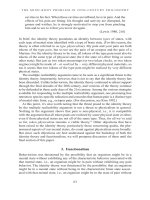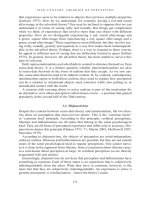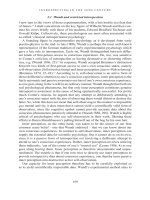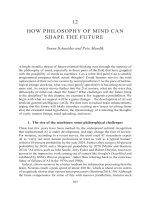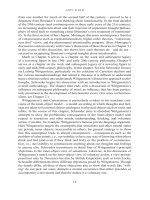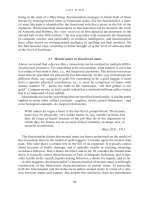Philosophy of mind in the twentieth and twenty first centuries the history of the philosophy of mind volume 6 ( PDFDrive ) (1) 226
Bạn đang xem bản rút gọn của tài liệu. Xem và tải ngay bản đầy đủ của tài liệu tại đây (100.28 KB, 1 trang )
I ntentionality
Although Brentano accepts this third criterion and doesn’t express any explicit
dissatisfaction with it, he thinks there is a better way of capturing what is distinctive
of mental phenomena, which brings us to what Brentano is most well known for.
4. All and only mental phenomena have intentionality. This is of course based
on Brentano’s famous passage:
Every mental phenomenon is characterized by what the Scholastics of the
Middle Ages called the intentional (or mental) inexistence of an object,
and what we might call, though not wholly unambiguously, reference to
a content, direction toward an object (which is not to be understood here
as meaning a thing), or immanent objectivity. Every mental phenomenon
includes something as object within itself, although they do not all do so in
the same way. In presentation, something is presented, in judgment something is affirmed or denied, in love loved, in hate hated, in desire desired
and so on. . . . This intentional in-existence is characteristic exclusively
of mental phenomena. No physical phenomenon exhibits anything like it.
We can, therefore, define mental phenomena by saying that they are those
phenomena which contain an object intentionally within themselves.
(68/88–89)
Although this was Brentano’s favored way of distinguishing mental phenomena
from physical phenomena – “Nothing distinguishes mental phenomena from
physical phenomena more than the fact that something is immanent as an object
in them” (152/197) – what it amounts to is ‘not wholly unambiguous’. For in this
short passage, Brentano provides four ways of characterizing mental phenomena.
Mental phenomena essentially involve:
•
•
•
intentional (or mental) inexistence of an object;
reference to a content;
direction to an object (although ‘object’ is not to be understood here as meaning a thing);17
and
• immanent objectivity.
Later in the same chapter, Brentano adds a fifth by characterizing mental phenomena in terms of “the reference to something as an object” (74/97).
In the end, it is arguable that Brentano means the same thing by all of these
expressions. In contemporary philosophy they are all replaced by the term ‘intentionality’, and intentionality is then typically characterized in terms of ‘aboutness’, ‘of-ness’ or ‘object directedness’.
The key to seeing the interchangeability of these expressions, perhaps, is to see
the relationship between the phrases ‘direction to an object’ and the ‘intentional
inexistence of an object’.18 There has been a great deal of debate about Brentano’s
207

